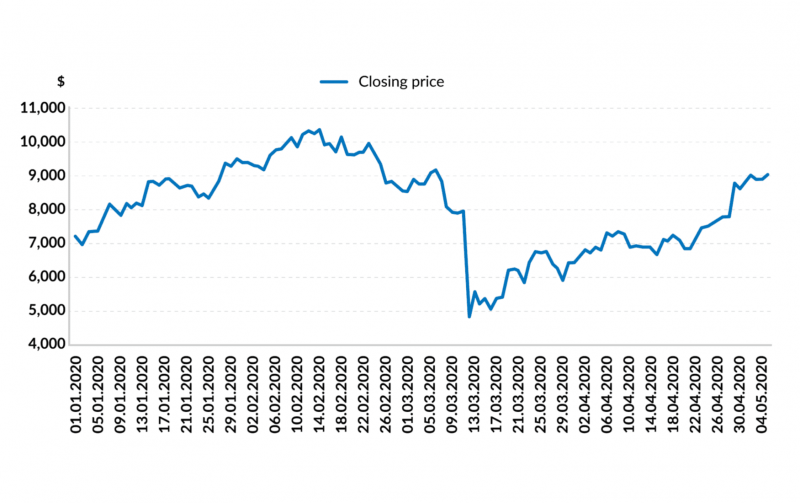With the rising popularity of cryptocurrencies, more techniques and strategies are surfacing in the trading world to analyze financial markets and predict trends. Especially with the staggering BTC prices, speculating on future movements has become essential for traders.
The Bitcoin power law is a unique theory that predicts the future price from a logarithmic approach. It plots historical data on a chart to make predictions and offers an opportunity to capitalize on potential price surges. Let’s explain how this theory works and how you can use it in crypto trading.
Key Takeaways
- The Bitcoin power law theory helps predict BTC prices using previous price data and repetitive market cycles.
- Traders can use the power-law relationship to identify market entry and exit zones and make investment decisions.
- The theory does not account for technological disruptions, regulatory changes, black swan events, or Bitcoin network changes that can affect the trading and market dynamics.
Understanding The Bitcoin Power Law Theory
The power law is a mathematical theory indicating that Bitcoin prices follow a predictable pattern, following a power-law distribution. It works by plotting historical prices on a logarithmic scale (Y-axis) in the Bitcoin power law chart, compared to the timeline on the X-axis.
The resulting line represents the exponential growth of Bitcoin price within bands that widen and narrow at a consistent rate over time.
The power law model in Bitcoin works in other social phenomena and studies, such as the distribution of wealth or the growth of animal claws. The name refers to the mathematical relationship where one factor grows as a power of the other.
In this scenario, the price correlates with time and adoption metrics in a non-linear but consistent manner, reflecting a long-term exponential trend.

Constructing The Bitcoin Power Law Chart
The first step in developing the power line chart for Bitcoin prices is to convert the X and Y axes to a logarithmic scale, which is a way of displaying numerical data that increases exponentially and not linearly.
Then, we plot previous BTC prices on the log-log graph and perform a linear regression to identify the straight line that represents the long-term Bitcoin prices.
Then, price deviations derived from the regression line are used to depict the support and resistance levels and determine the overbuying and overselling zones. Some power-law Bitcoin graphs create intermediate resistance and support levels around the 20% or 40% levels for in-depth analysis.

How is The Theory Used in Practice?
The power-law framework is predictive and speculative, using mathematical calculations and probabilities to draw logical conclusions for Bitcoin price analysis. Here’s how this theory is used.
Predict Trends
The historical price growth within the regression line and bands can help identify potential price ranges and upcoming trends. Allowing traders to determine buy or sell signals and execute orders accordingly.
Analyse Market Cycles
The dotted ups and downs depicted using the price data represent the Bitcoin market cycle, which can be used to predict upcoming movements. This happens because BTC prices usually follow a predictable pattern within the regression bands.

Measure Volatility
Traders can analyze the historical price fluctuations over the previous years to create volatility patterns. This helps predict times when Bitcoin prices stabilize as adoption increases or become volatile after specific events.
Make Investment Decisions
Assuming Bitcoin follows the same pattern it has been drawing over the past years, traders can determine the best entry and exit levels and make long-term investment decisions.
How to Predict Bitcoin Prices Using The Power Law?
BTC price analysis using the power-law chart is done after identifying the support and resistance levels, including the extreme (outer) lines and the intermediate lines like 25%, 50, and 75% limits. These bands represent historical deviations and act as zones of probability where the price can oscillate.
Observe the market price according to the following principle:
- If the line is near the top band, it signals overbuying, where the price is peaking.
- If the line is near the bottom, it signals overselling, where the price is hitting the bottom.
- Movements along the intermediate bands represent support and resistance zones, marking potential entry and exit points.
Despite offering valuable insights into long-term projections, it remains speculative and should be combined with other market factors for accuracy and close attention to unpredictable breakthroughs and reversions.
The Italian economist Vilfredo Pareto established the broader power laws in the 19th century. Later, the Italian physicist Giovanni Santostasi applied mathematical principles to model price trajectory, which is used today in the Bitcoin power-law theory.
Shortcomings of The BTC Power Law
The Bitcoin power law chart is not a fool-proof method as it remains speculative. The infancy of the crypto market, considering these assets have been around for just over a decade, makes this theory alone unreliable for making absolute predictions.
Therefore, there are multiple factors that make this paradigm invalid.
Technological Changes
Decentralized finance and cryptocurrencies involve cutting-edge technologies that change and advance very rapidly. Therefore, new innovations and introductions in blockchain can massively impact this predictive model.
The Bitcoin blockchain is one of the oldest and broadest public ledgers, where millions of transactions are tracked and recorded. Therefore, tech adoptions and new breakthroughs can be added to the ecosystem, largely affecting how BTC coins are registered, traded, and valued.
On the flip side, if massive technological failures happen, the entire ecosystem will be affected, and Bitcoin trading can potentially be suspended. This would create breakthroughs and new patterns that do not align with the power law.
Alternatively, if a new cryptocurrency takes over Bitcoin in popularity, utility, and scalability, it can potentially draw significant attention and change the dynamics of the whole market.
New Price Patterns
This model uses historical price data and market cycles. However, cryptocurrencies are highly unpredictable, and Bitcoin can go through an entirely new pattern that disrupts the previous price cycle and diminishes the theory’s validity in the future.
Regulatory Changes
This year, financial regulations and institutional adoptions highly accommodated cryptocurrencies, especially Bitcoin. The approval of crypto ETF spot trading, the widespread use of BTC payments, and the structured digital asset regulations spurred the market growth.
However, future regulatory changes or restrictions on crypto assets can significantly affect the dynamics of Bitcoin prices, rendering the theory invalid.
Unpredictable Market Events
Swan events are unforeseeable scenarios that impact national or global economies, which can largely change the theory’s principles.
Economic recession, global pandemic, crypto exchange collapse, and geopolitical instability are events that have substantially affected the crypto market over the past few years. As such, any future event of the same magnitude can unpredictably change the market dynamics.

Lack of Accuracy
The theory offers long-term price projections at broad prediction ranges, which limits its precision for specific investment decisions.
The model is designed to capture long-term trends, making it less reliable for short-term predictions, as cryptocurrency markets are highly volatile. These fluctuations can cause significant short-term deviations, leading to excessive investment losses.
Exclusion of Psychological Sentiment
Traders make decisions based on a combination of logical and emotional factors. While the theory studies the arithmetic reasoning behind the Bitcoin price, it cannot account for the trader’s sentiment.
Therefore, global events and economic instability massively affect the trader’s emotional decision-making outside the logical sense of the power-law theory.
Conclusion
The Bitcoin power-law theory is a complex mathematical paradigm that studies the previous price data across the years on a logarithmic scale. This physical system suggests that BTC prices follow a predictable trajectory that helps understand future trends and price movements.
It is a predictive theory that helps analyze prices, identify entry and exit zones, and understand market cycles. However, its speculative nature makes it unreliable during technological or regulatory drawbacks that can massively impact the dynamics outside the theory’s predictions.











